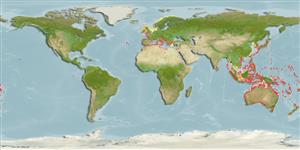Hydrozoa |
Anthoathecata |
Eudendriidae
Environment: milieu / climate zone / djupintervall / distribution range
Ekologi
; djupintervall 0 - 30 m (Ref. 3086). Subtropical
Indo-Pacific, Northeast Atlantic and Mediterranean.
Length at first maturity / Size / Weight / Age
Könsmognad: Lm ? range ? - ? cm Max length : 15.0 cm H hane/ej könsbestämd; (Ref. 3669)
Complementary nematocysts atrichous isorhizas, cnidophores present in some hydranths; male and female blastostyles reduced; spadix of female blastostyle bifurcated when immature; mature eggs scattered over main axis of blastostyle (Ref. 3086).
Occurs from depths of 0 to 30 m, on rocks, concretions, barnacles, mussels, and algae (Ref. 3086).
Life cycle and mating behavior
Könsmognad | Reproduktion | Lek | Eggs | Fecundity | Larvae
Members of the order Anthoathecata are mostly colonial A-form hydroids. Life cycle: The zygote develops into planula inside the gonophore and is later released as an actinula which metamorphoses into polyp stage.
Medel, M.D. and P.J. López-González 1996 Updated catalogue of hydrozoans of the Iberian Peninsula and Balearic Islands, with remarks on zoogeography and affinities. Scientia Marina 60(1):183-209. (Ref. 3327)
IUCN Red List Status
(Ref. 130435: Version 2025-1)
CITES status (Ref. 108899)
Not Evaluated
Not Evaluated
Threat to humans
Harmless
Human uses
| FishSource |
Verktyg
Ytterligare information
Trophic EcologyFood items (preys)FödosammansättningFödointagPredatorer Population dynamicsTillväxtMax. ages / sizesLength-weight rel.Length-length rel.Length-frequenciesMass conversionAbundans PhysiologySyreförbrukning
Human RelatedStamps, coins, misc.
Internet-källor
Estimates based on models
Preferred temperature
(Ref.
115969): 15.7 - 29.2, mean 27.4 (based on 3360 cells).
Fishing Vulnerability
Low vulnerability (10 of 100).
Price category
Unknown.
